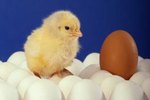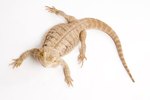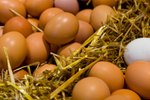
Hatching your own eggs can ensure your particular line of fowl and can enable you to own more exotic breeds of poultry. Whether you have an expensive and fancy incubator, or build your own from simple materials such as a Styrofoam cooler and a heating element, you must ensure your incubator maintains the proper temperature to hatch your birds. Proper temperatures vary among types of incubators, and knowing the right one is important for a successful hatch.
Still-Air Incubators
The lowest-cost form of incubators is the "still-air" incubator. Unlike incubators with a fan or other type of air-circulation system, still-air designs rely on the heat to rise and the air to flow naturally through the incubator. These incubators a require temperature of 102 degrees Fahrenheit, because the top of the egg is warmer than the bottom of the egg. Despite discrepancies in temperature, the egg will have an average of 100 degrees Fahrenheit.
Forced-Air Incubators
"Forced-air" incubators have fans or other modes of circulating air around the egg, thus maintaining a constant temperature throughout the incubator. These incubators should have a temperature between 99 and 100 degrees Fahrenheit for consistent hatching. These temperatures work for all fowl, regardless of species.
Incubator Placement
You need to place your incubator somewhere that has a consistent temperature, away from drafts and windows that can cause the incubator's temperature to fluctuate. Having an incubator by a window or in a sunny spot may cause the incubator to become too hot or cold, thus killing or damaging the embryos. Keeping an accurate thermometer with an alarm for fluctuations -- too high or too low -- will help you maintain a consistent temperature.
Other Considerations
Eggs need to be turned at least three times a day, either with an automatic turner or by hand. Turning ensure that the embryo doesn't stick to one side of the egg. If you hand-turn your eggs, you need to do it quickly or the temperature may drop and you run the risk of killing the embryos or causing hatch problems.
Humidity also is vitally important for a good hatch. Too much and you'll drown the chicks; too little and the chicks won't be able to hatch. Have the relative humidity at 50 to 55 percent during incubation and 65 percent during the last three days. You can increase humidity using a pan of water and decrease the humidity by opening vents. A hygrometer will help you determine relative humidity.
References
Photo Credits
-
David De Lossy/Photodisc/Getty Images




